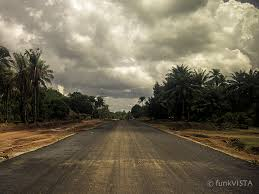August 17, 2017
The Folly of Uncritical Road ConstructionA recent drive along Sierra Leone's new Lunghi-Port Loko highway revealed some forty miles of immaculately laid-out tarmac, smooth and well-marked, connecting the country's sole international airport with one of its principal towns. It cuts through terrain that is overwhelmingly bush, interspersed very, very occasionally by a few modest dwellings. Traffic on the road was exceedingly light; stretches of several miles regularly went by without sight of another vehicle. The road was built (actually upgraded, as a poorly-maintained link had been in existence for many years) at a projected cost of almost 40 million US dollars, a grant from the African Development Bank's Fragile States Fund. Was this, or indeed other investments like this around Africa, a sound investment?
We are often told that the life of a well designed and constructed road is 30 years. The hope, no doubt, is that during this period the road can be seen to have "paid for itself" in some fashion. In the strict economic sense, it is hoped that the road would spur additional economic activity that would eventually exceed the cost of the road itself and justify the initial investment. In its project appraisal report (April 2009), the ADB claims a 16% rate of return for the project, although we are not shown exactly how this figure is arrived at. When the British built the railway in Sierra Leone in the early 1900s they sought out cocoa, coffee and palm kernel producing areas that would provide a ready economic base for the new railroad. In the case of Sierra Leone's newest highway, no such base is apparent. The projection during the
 project appraisal was that the road
would stimulate agricultural activity in the surrounding areas, which
are flat and green, apparently prime agricultural land. No such
stimulus appears to have taken place since the completion of the
highway in 2013. The most prominent agricultural feature along the
route are tall and very old coconut trees, apparently the dying
remnants of some ancient plantation. The hope that a new highway on its
own, absent other enabling conditions, might stimulate agricultural
production appears to be a forlorn one. Sierra Leone has several other
highways, including the Masiaka-Waterloo road that completes the
journey into Freetown, that prove this point.
project appraisal was that the road
would stimulate agricultural activity in the surrounding areas, which
are flat and green, apparently prime agricultural land. No such
stimulus appears to have taken place since the completion of the
highway in 2013. The most prominent agricultural feature along the
route are tall and very old coconut trees, apparently the dying
remnants of some ancient plantation. The hope that a new highway on its
own, absent other enabling conditions, might stimulate agricultural
production appears to be a forlorn one. Sierra Leone has several other
highways, including the Masiaka-Waterloo road that completes the
journey into Freetown, that prove this point. For a developing country with limited funds each dollar spent needs to be carefully analyzed for economic efficiency. Could this money be better spent elsewhere? Is this the best use of scarce resources? One should thus look at that forty million US dollars and determine whether greater gains could have been secured elsewhere:
Education With university fees of around Le10,000,000 (USD 1,300) per annum, let's assume for argument's sake that it costs USD 10,000 to train a graduate - hopefully an engineer, doctor, scientist or other STEM professional. Let's also assume that the new graduate commands a premium of Le1,500,000 (USD 200) monthly in additional salary over his untrained counterpart. One could quibble with the specific figures, but the attempt here is to gain an approximate picture - the figures need not be precise. Thus the new graduate earns 12x200 = USD 2,400 in additional annual income over his untrained
One could make similar arguments in other spheres, particularly well-planned investments in agriculture and industry. The point here is not to argue that we don't need additional road construction. We do. But that construction needs to be well planned, underpinned by a solid economic base. To simply argue that because we have constructed a road from point A to point B we have "brought development" is simplistic. In thirty or forty years time some of these roads would be at the end of their design life with very little to show for their existence.